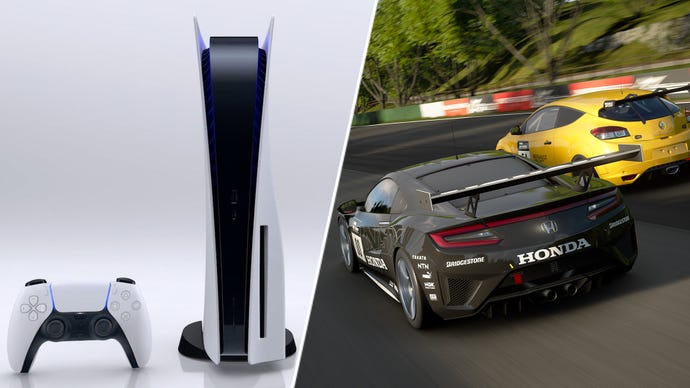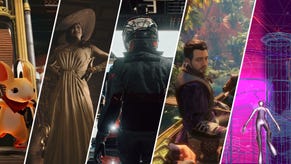Gran Turismo 7 brings obsessive detail back to the series, and is all the better for it
Oil changes and car washes: confirmed.
What always set Gran Turismo apart was the little details. We all went and bought it because it was the real driving simulator, and it backed that statement up with licensed cars and realistic stopping distances. But what made us stick around and play it obsessively thereafter was that it was so fastidious about car culture. It gave us incredibly faithful models of really normal cars you might see in a Morrisson’s car park, like a Toyota Yaris or a Nissan Micra, and there was a thrill to tuning one up and watching it smoke a Mitsubishi FTO.
It trusted us to know about 2-way LSDs, and it correctly assumed we’d be as fascinated with rare Japanese vintage models, oil changes, and car washes as its creators obviously were. Above all, that tradition for going the extra mile in the name of vehicular obsession is why we’re all watching Gran Turismo 7 so keenly.
For its part, Polyphony Digital seems to have recognised exactly why its franchise is so beloved and doubled down on those meticulous, infectiously obsessive details this time. Maybe it took a dramatic departure like GT Sport for the studio to realise how much players loved car ownership and trawling used car dealers for rarities. In any event, GT7 feels much more like the sprawling, detail-filled GT5 and its PS2 forebear GT4 than its immediate predecessor.
That begins with something as simple as its menu layout. Looking at that career mode screen, an arrangement of icons on a map that mimics those of GT5 and beyond, feels like a warm, reassuring hug from Polyphony. "Shh", it seems to be saying, "it’s okay again now. We’re not just trying to make you into a sim racer anymore. You can buy a Demio and take part in the Sunday Cup like the old days."
Mazda Demios and the Sunday Cup were, in fact, both visible in GT7’s recent virtual press briefing, along with oil changes and car washes. There’s a lot of meaning in those brief flashes of returning legacy features. Which other franchise would it have occurred to that players might enjoy simulated dirt build-up on their cars, and the ability to watch virtual men wash that dirt off? It’s a totem of what makes GT special, and it matters a great deal that such an ostensibly minor feature’s back.
Despite this tacit messaging, it isn’t simply a matter of wheeling out the old PS3 game template again with better visuals. Here’s a game that, as ever, has new ideas that are as esoteric as they are exciting, so obviously the product of genuine affection for, and fixation with, automotive history.
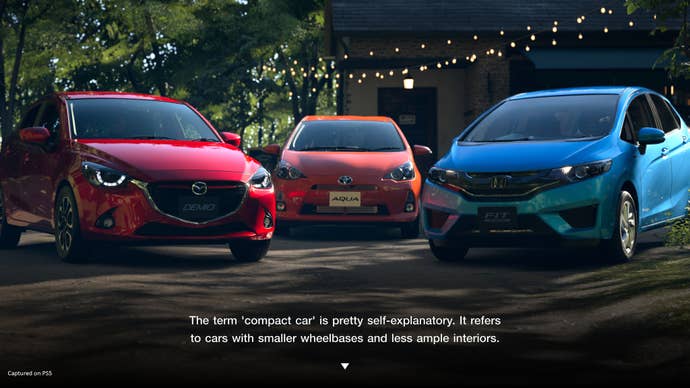
You can find that exemplified in the Cafe. Its menu backdrop is a group of classic cars parked outside an actual cafe like cyclists on a latte break, but in fact forms the centre point of GT7’s car culture aspect. Within it you’ll find themed activities like car collection objectives and driving challenges, but it’s also where key figures from automotive history like the designers of the car you’re driving turn up to share their memories.
There’s a quiet dignity about it, like so many of Gran Turismo’s nuts and bolts. There are progress meters increasing, and objectives being ticked off in menus – this being a video game in 2022, after all. But there’s also slow jazz and beautifully constructed cafe scenery. Honestly, I could almost smell the coffee beans.
Will Forza be losing sleep over this new feature? Probably not, honestly. But although the two occupy similar territory in many ways – vast car collections, huge audiences, amazing visuals – in truth they’re worlds apart in execution. Gran Turismo 7 will absolutely never ask you to smash 50 cacti for a prize. You’ll never hear a voice telling you to get over to a particular circuit because it’s about to 'go off'. Polyphony’s game is a more meditative, stately take on the all-encompassing driving game, and the cafe deepens that singular approach.
Not all the new features are so easy to find excitement in, or even to grasp at all. Music Rally events, for example. Enter one of these and you’re embarking on a fairly straightforward checkpoint race on paper. But instead of seconds, the currency keeping you racing is beats. These beats deplete at the rate of the song you’re listening to, and replenish when you hit a checkpoint. So a slow-paced track will be easier to drive along to than a high-BPM EDM number. It’s a nod to a common fan request for a mode that lets you simply drive for the sake of enjoying the scenery and the music, says Polyphony’s legendary CEO Kaz Yamauchi. But based on its initial showing, it doesn’t seem to deliver that. The mood of that checkpoint racing doesn’t come across as zen, but almost as frantic as any other race event. It’s a bit confusing at present.
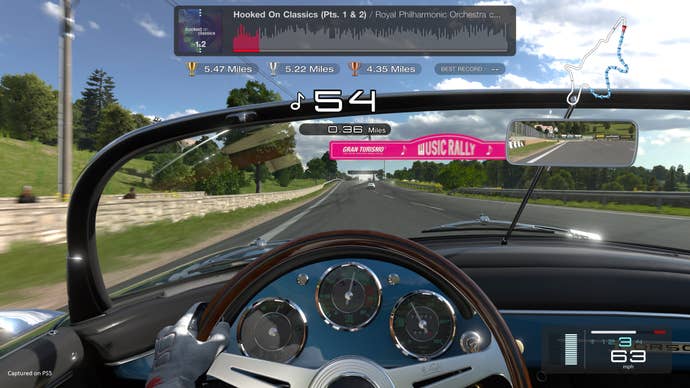
The studio’s evidently very proud of the new Music Replay function, too. It’s possible I’m missing something more profound about it, but it appears to be a system for syncing camera angle changes to the beats of a song in replays. So when you watch your driving retrospectively, the shots will cut on the first beat of the bar. Apparently this came about after Yamauchi and the team got into the habit of finishing their days in the soundproof recording studio, jamming on their instruments. Feeling inspired to make music a more central part of the Gran Turismo experience this time, they eventually arrived on Music Replay. It typifies the spirit of a studio who examines every fiber of its game and looks for a way to add something to it, but whether the addition is especially valuable remains to be seen.
None of which should furrow one’s brow overly. Driving cars very quickly along tracks is still the primary order of business, and to that end GT7 brings 97 layouts over 34 tracks, as ever mixing real-world locations with the franchise’s own famous circuit layouts. If you don’t find yourself bewitched by Music Rally, or watching beat-synced replays, that's fine – they aren't the bulk of the game, after all.
As for the car collection itself, 400 are available on day one and more will be added in post-launch updates. That’s a much lower vehicle count than the 1197 that GT6 offered, and while GT6 achieved it using some sketchy PS2 ports without interior cameras, the number itself did speak to GT’s ambition as an automotive encyclopedia.
What GT7 does offer, though, is what appears to be the deepest and most meaningful level of car ownership yet. Tuning makes a welcome return to the series in GT7, and it takes place on a set of screens designed for ease of use and quick changes, and where you can quickly run a simulation based on power, weight and grip to generate its new performance number. It’s one of Yamauchi’s favourite features of his new game, and it can be used to get a decrepit Volkswagen Beetle hooning around Brands Hatch faster than a Porsche 911 in a few streamlined button presses.
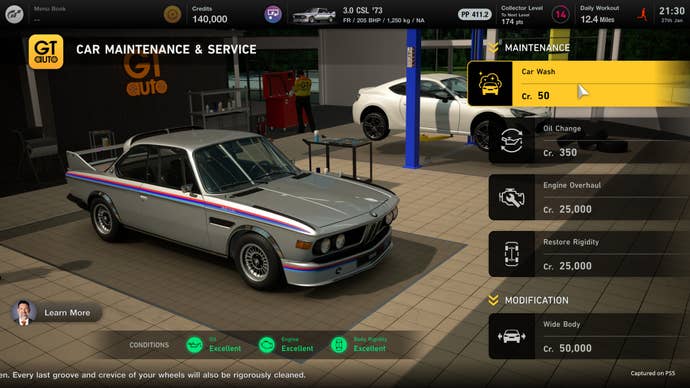
Deeper still, the visual aspect of customisation’s come on in leaps and bounds. There are over 600 visual parts, excluding all the rims, to add to cars, including full widebody kit conversions, and a fully-fledged livery creator to rival Forza’s. With all these variables on offer, there’s an infinitesimally small chance that your Mazda Demio will look and drive like mine. Unless we download each others’ liveries from the UGC exchange, of course. Both helmets and race suits were spotted here, incidentally, although performance tunes themselves can’t be shared and applied to vehicles. Instead, you’ll have to share screenshots of your tuning menus to let others in on your magical alchemy of gear ratios and wheel toe-in.
To this longstanding fan, GT7’s priorities appear almost exactly where I’d want them. All the content I’d consider fundamental to the GT experience is back and feels enriched in some way, but it’s paired with new features that will make that familiar rags to riches story from Demio to Le Mans Prototype feel fresh, such as its revamped weather system and online racing filled with GT Sport’s learnings. It’s no longer the only driving simulator, but it still feels like the real one.
